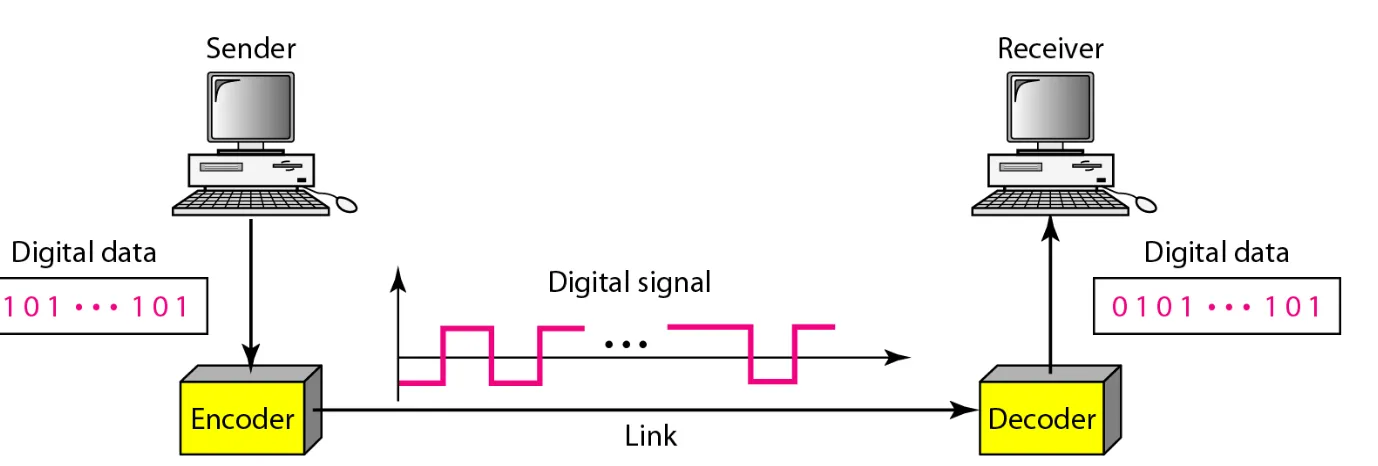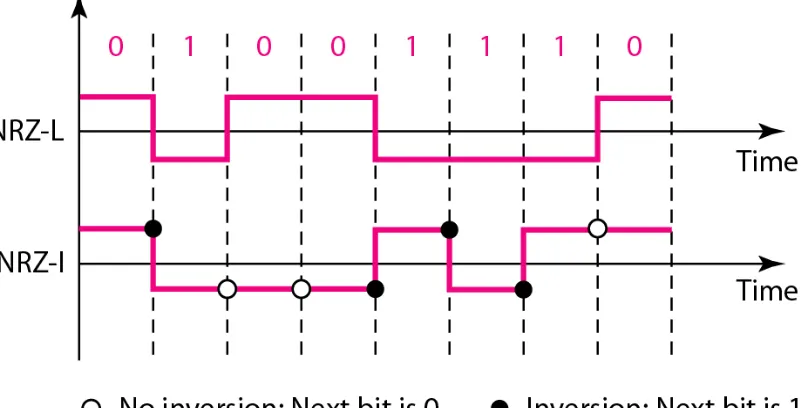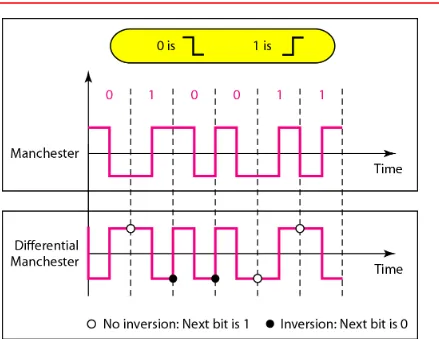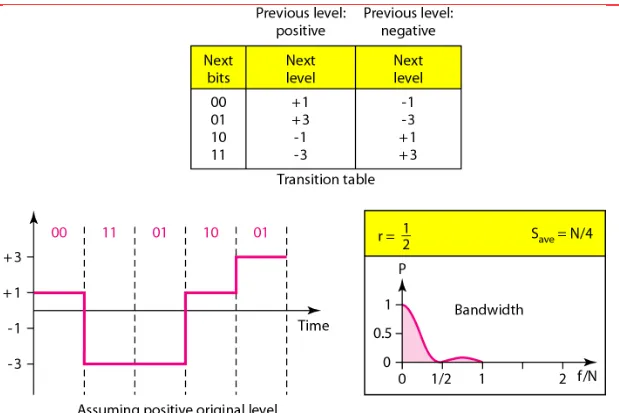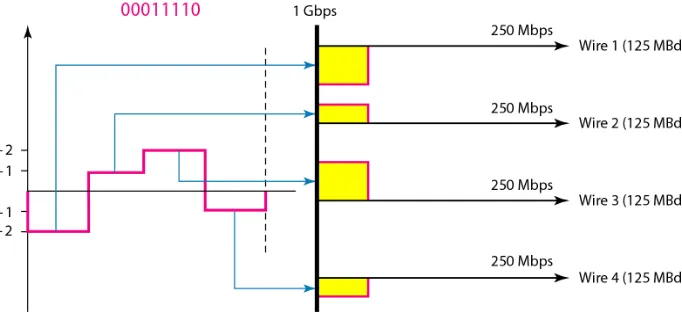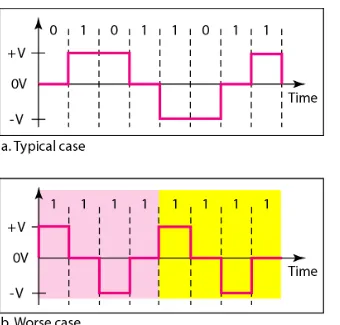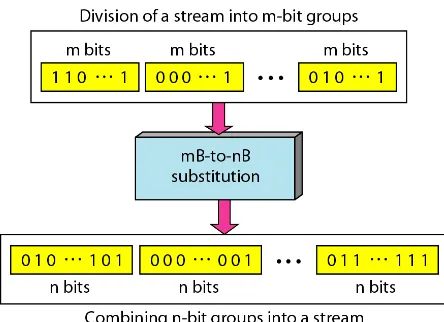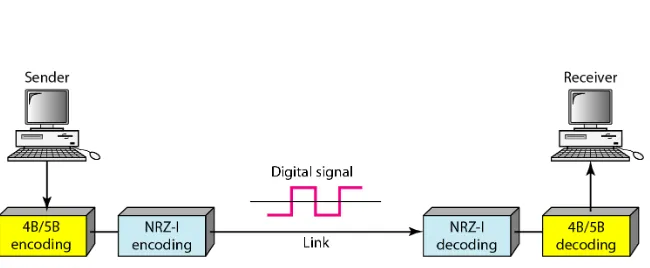4.1
Chapter 4
Digital Transmission
4.2
4-1 DIGITAL-TO-DIGITAL CONVERSION
4-1 DIGITAL-TO-DIGITAL CONVERSION
In this section, we see how we can represent digital
In this section, we see how we can represent digital
data by using digital signals. The conversion involves
data by using digital signals. The conversion involves
three techniques:
three techniques: line codingline coding, block coding, block coding, and , and
scrambling
scrambling. Line coding is always needed; block . Line coding is always needed; block coding and scrambling may or may not be needed.
coding and scrambling may or may not be needed.
Line Coding
Line Coding Schemes Block Coding
Scrambling
Topics discussed in this section:
4.3
4.4
4.5
A signal is carrying data in which one data element is encoded as one signal element ( r = 1). If the bit rate is 100 kbps, what is the average value of the baud rate if c is between 0 and 1?
Solution
We assume that the average value of c is 1/2 . The baud rate is then
4.6
Although the actual bandwidth of a
digital signal is infinite, the effective
bandwidth is finite.
4.7
The maximum data rate of a channel (see Chapter 3) is Nmax = 2 × B × log2 L (defined by the Nyquist formula).
Does this agree with the previous formula for Nmax?
Solution
A signal with L levels actually can carry log2L bits per level. If each level corresponds to one signal element and we assume the average case (c = 1/2), then we have
4.8
4.9
In a digital transmission, the receiver clock is 0.1 percent faster than the sender clock. How many extra bits per second does the receiver receive if the data rate is 1 kbps? How many if the data rate is 1 Mbps?
Solution
At 1 kbps, the receiver receives 1001 bps instead of 1000 bps.
Example 4.3
4.10
4.11
4.12
4.13
In NRZ-L the level of the voltage
determines the value of the bit.
In NRZ-I the inversion
or the lack of inversion
determines the value of the bit.
4.14
NRZ-L and NRZ-I both have an average
signal rate of N/2 Bd.
4.15
NRZ-L and NRZ-I both have a DC
component problem.
4.16
A system is using NRZ-I to transfer 10-Mbps data. What are the average signal rate and minimum bandwidth?
Solution
The average signal rate is S = N/2 = 500 kbaud. The minimum bandwidth for this average baud rate is Bmin = S = 500 kHz.
4.17
4.18
4.19
In Manchester and differential
Manchester encoding, the transition
at the middle of the bit is used for
synchronization.
4.20
The minimum bandwidth of Manchester
and differential Manchester is 2 times
that of NRZ.
4.21
In bipolar encoding, we use three levels:
positive, zero, and negative.
4.22
4.23
In
m
B
n
L schemes, a pattern of
m
data
elements is encoded as a pattern of
n
signal elements in which 2
m≤ L
n.
4.24
4.25
4.26
4.27
4.28
4.29
Block coding is normally referred to as
m
B/
n
B coding;
it replaces each
m
-bit group with an
n
-bit group.
4.30
4.31
4.32
4.33
4.34
We need to send data at a 1-Mbps rate. What is the minimum required bandwidth, using a combination of 4B/5B and NRZ-I or Manchester coding?
Solution
First 4B/5B block coding increases the bit rate to 1.25 Mbps. The minimum bandwidth using NRZ-I is N/2 or 625 kHz. The Manchester scheme needs a minimum bandwidth of 1 MHz. The first choice needs a lower bandwidth, but has a DC component problem; the second choice needs a higher bandwidth, but does not have a DC component problem.
4.35
4.36
4.37
4.38
B8ZS substitutes eight consecutive
zeros with 000VB0VB.
4.39
4.40
HDB3 substitutes four consecutive
zeros with 000V or B00V depending
on the number of nonzero pulses after
the last substitution.
4.41
4-2 ANALOG-TO-DIGITAL CONVERSION
4-2 ANALOG-TO-DIGITAL CONVERSION
We have seen in Chapter 3 that a digital signal is
We have seen in Chapter 3 that a digital signal is
superior to an analog signal. The tendency today is to
superior to an analog signal. The tendency today is to
change an analog signal to digital data. In this section
change an analog signal to digital data. In this section
we describe two techniques,
we describe two techniques, pulse code modulationpulse code modulation
and
and delta modulationdelta modulation. .
Pulse Code Modulation (PCM) Delta Modulation (DM)
Topics discussed in this section:
4.42
4.43
4.44
According to the Nyquist theorem, the
sampling rate must be
at least 2 times the highest frequency
contained in the signal.
4.45
4.46
For an intuitive example of the Nyquist theorem, let us sample a simple sine wave at three sampling rates: fs = 4f (2 times the Nyquist rate), fs = 2f (Nyquist rate), and fs = f (one-half the Nyquist rate). Figure 4.24 shows the sampling and the subsequent recovery of the signal.
It can be seen that sampling at the Nyquist rate can create a good approximation of the original sine wave (part a). Oversampling in part b can also create the same approximation, but it is redundant and unnecessary. Sampling below the Nyquist rate (part c) does not produce a signal that looks like the original sine wave.
4.47
4.48
Consider the revolution of a hand of a clock. The second hand of a clock has a period of 60 s. According to the Nyquist theorem, we need to sample the hand every 30 s (Ts = T or fs = 2f ). In Figure 4.25a, the sample points, in order, are 12, 6, 12, 6, 12, and 6. The receiver of the samples cannot tell if the clock is moving forward or backward. In part b, we sample at double the Nyquist rate (every 15 s). The sample points are 12, 3, 6, 9, and 12. The clock is moving forward. In part c, we sample below the Nyquist rate (Ts = T or fs = f ). The sample points are 12, 9, 6, 3, and 12. Although the clock is moving forward, the receiver thinks that the clock is moving backward.
4.49
4.50
An example related to Example 4.7 is the seemingly backward rotation of the wheels of a forward-moving car in a movie. This can be explained by under-sampling. A movie is filmed at 24 frames per second. If a wheel is rotating more than 12 times per second, the under-sampling creates the impression of a backward rotation.
4.51
Telephone companies digitize voice by assuming a maximum frequency of 4000 Hz. The sampling rate therefore is 8000 samples per second.
4.52
A complex low-pass signal has a bandwidth of 200 kHz. What is the minimum sampling rate for this signal?
Solution
The bandwidth of a low-pass signal is between 0 and f, where f is the maximum frequency in the signal. Therefore, we can sample this signal at 2 times the highest frequency (200 kHz). The sampling rate is therefore 400,000 samples per second.
4.53
A complex bandpass signal has a bandwidth of 200 kHz. What is the minimum sampling rate for this signal?
Solution
We cannot find the minimum sampling rate in this case because we do not know where the bandwidth starts or ends. We do not know the maximum frequency in the signal.
4.54
4.55
What is the SNRdB in the example of Figure 4.26?
Solution
We can use the formula to find the quantization. We have eight levels and 3 bits per sample, so
SNRdB = 6.02(3) + 1.76 = 19.82 dB
Increasing the number of levels increases the SNR.
4.56
A telephone subscriber line must have an SNRdB above 40. What is the minimum number of bits per sample?
Solution
We can calculate the number of bits as
Example 4.13
4.57
We want to digitize the human voice. What is the bit rate, assuming 8 bits per sample?
Solution
The human voice normally contains frequencies from 0 to 4000 Hz. So the sampling rate and bit rate are calculated as follows:
4.58
4.59
We have a low-pass analog signal of 4 kHz. If we send the analog signal, we need a channel with a minimum bandwidth of 4 kHz. If we digitize the signal and send 8 bits per sample, we need a channel with a minimum bandwidth of 8 × 4 kHz = 32 kHz.
4.60
4.61
4.62
4.63
4-3 TRANSMISSION MODES
4-3 TRANSMISSION MODES
The transmission of binary data across a link can be
The transmission of binary data across a link can be
accomplished in either parallel or serial mode. In
accomplished in either parallel or serial mode. In
parallel mode, multiple bits are sent with each clock
parallel mode, multiple bits are sent with each clock
tick. In serial mode, 1 bit is sent with each clock tick.
tick. In serial mode, 1 bit is sent with each clock tick.
While there is only one way to send parallel data, there
While there is only one way to send parallel data, there
are three subclasses of serial transmission:
are three subclasses of serial transmission:
asynchronous, synchronous, and isochronous.
asynchronous, synchronous, and isochronous.
Parallel Transmission Serial Transmission
Topics discussed in this section:
4.64
4.65
4.66
4.67
In asynchronous transmission, we send
1 start bit (0) at the beginning and 1 or
more stop bits (1s) at the end of each
byte. There may be a gap between
each byte.
4.68
Asynchronous here means
“asynchronous at the byte level,”
but the bits are still synchronized;
their durations are the same.
4.69
4.70
In synchronous transmission, we send
bits one after another without start or
stop bits or gaps. It is the responsibility
of the receiver to group the bits.
4.71
